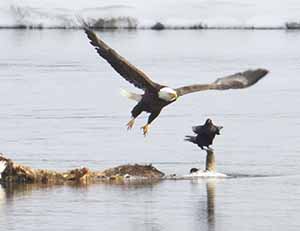Bald Eagles
Updated: August 12, 2020

In 1978 bald eagles throughout the lower 48 states were classified as endangered. The bald eagle was in serious danger of becoming extinct. Harmful chemicals had affected the reproduction of eagles, causing a rapid decrease in their numbers. Excessive hunting and the destruction of eagle habitat also played major roles in the decline of the species.
In the past few decades the bald eagle has made a tremendous comeback, its populations greatly improving in numbers. On July 12, 1995 the status of the bald eagle was changed from endangered species to a threatened one in the lower 48 states. It has taken a lot of hard work and dedication from people across the nation. There is still a lot of work to be done but the bald eagle is now soaring toward recovery! Each year bald eagles return in increasing numbers to Montana for the salmon run. Fall migrating eagles find spawning salmon, salmon that are depositing eggs below Canyon Ferry Dam and below the turbines of Libby Dam on the Kootenai River; and can eat up to six salmon in one day.
The bald eagle is the only eagle unique to North America. It ranges over most of the continent from the northern reaches of Alaska and Canada down to northern Mexico. Not all eagles migrate but there are many bald eagles that migrate south from Canada through Montana every year. Generally the eagles follow seasonal food supplies. As lakes and streams freeze over, bald eagles must fly south to find open freshwater or head to the coast.

One of the largest raptors, the bald eagle is about 3 feet from head to tail with a wingspan of 6 to 8 feet, yet it only weighs between 9 and 14 pounds (females are larger than males). Eagle bones are light because they are hollow. The skeleton weighs about half a pound and is only 5 or 6 percent of its total weight. The feathers weigh twice that much! The bald eagle's name comes from and old English word balde that means white. Their heads, necks and tails have white feathers. Young bald eagles are hard to identify because their white head and tail feathers don't appear until it is a full five yers old.
Bald eagles are powerful fliers that can reach flight speeds between 35 and 44 miles per hour and can soar for hours on end. These strong fliers have about 7,000 feathers. A perched eagle will sit in a tree and preen itself by nibbling on a special oil gland above its tail and smooth the oil over its feathers to keep water from soaking through to the down feathers, which protect the eagle’s skin and keep the bird warm.
Eagles make very large nests, which they add to every year. Some nests may reach 10 feet across and weigh as much as 2,000 pounds! They build their nests at the tops of trees close to water where they can catch fish to feed their young. A female bald eagle will lay two or three eggs in the nest each year after reaching adulthood.
All eagles are renowned for their excellent eyesight and the bald eagle is no exception. While in flight bald eagles are capable of seeing fish in the water from several hundred feet above. An eagle's eye is almost as large as a human's but its sharpness is at least four times that of a human with perfect vision. And eagles like all birds have color vision.
The bald eagle is a beautiful and fascinating animal! But it is still on the road to recovery. Please protect and respect our national symbol, the bald eagle.
Updated: August 10, 2020



